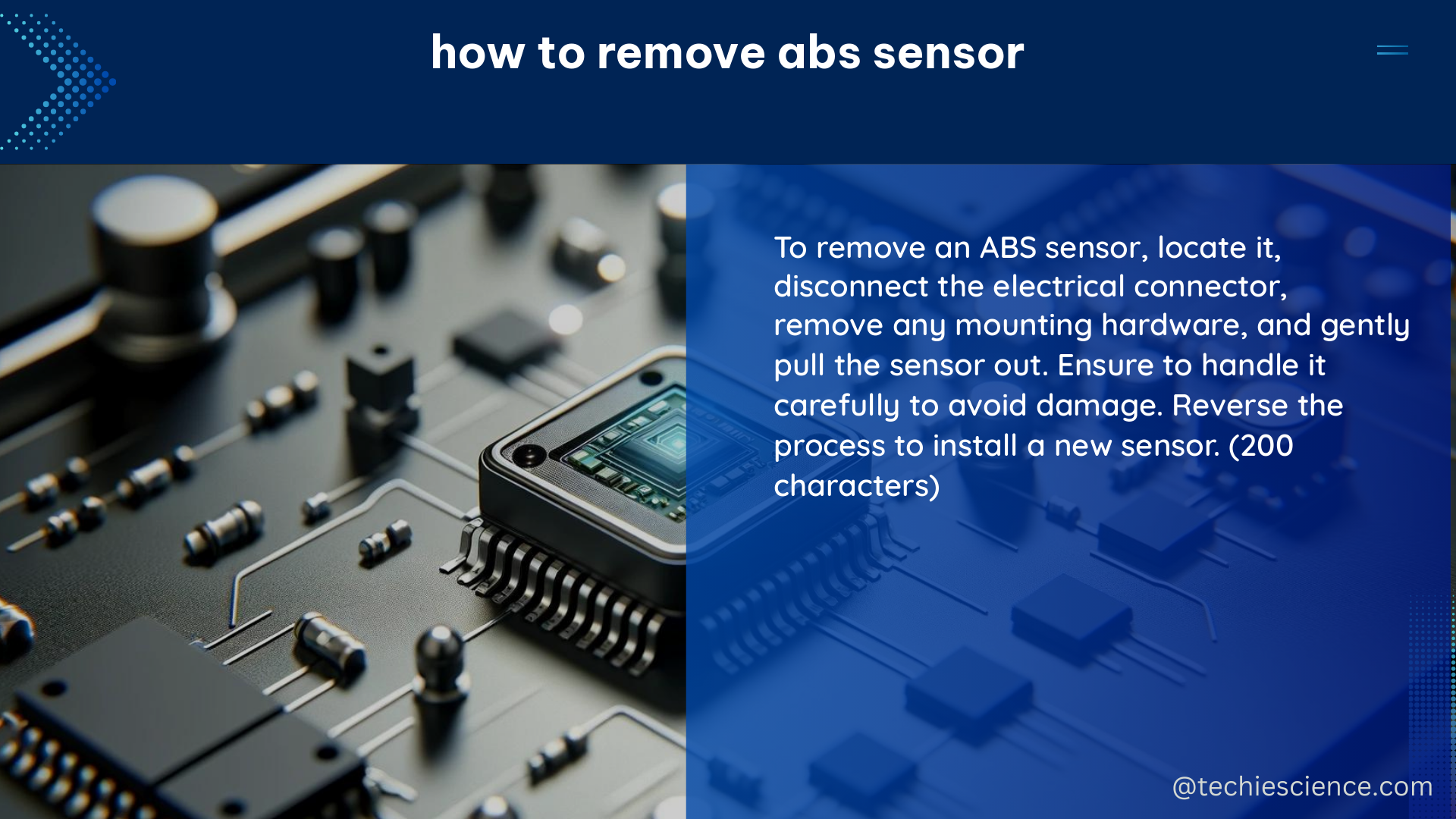Removing an ABS (Anti-lock Braking System) sensor can be a crucial task for vehicle maintenance and troubleshooting. This comprehensive guide will walk you through the step-by-step process of safely and effectively removing an ABS sensor, along with detailed technical specifications to ensure a successful DIY experience.
Identifying the ABS Sensor Location
The ABS sensor is typically located near the wheel hub and is connected to the wheel speed sensor. It is responsible for monitoring the rotational speed of the wheels, which is essential for the proper functioning of the anti-lock braking system. The sensor is usually positioned in close proximity to the wheel, making it easily accessible for removal.
Disconnecting the Electrical Connector

Before removing the ABS sensor, it is crucial to disconnect the electrical connector attached to it. This can typically be done by pressing the tab on the connector and gently pulling it away from the sensor. Disconnecting the electrical connector ensures that there is no power supply to the sensor, which helps prevent any potential electrical hazards during the removal process.
Removing the ABS Sensor
The ABS sensor is usually held in place by a bolt or clip. To remove the sensor, you will need to use the appropriate tools, such as a wrench or pliers, to loosen and remove the bolt or clip. Once the fastener is removed, you can carefully pull the sensor out of its housing.
Inspecting the ABS Sensor
After removing the ABS sensor, it is essential to inspect it for any signs of damage or wear. If the sensor appears to be in good condition, it can be reused. However, if there are any visible signs of damage, such as cracks, corrosion, or worn components, it is recommended to replace the sensor with a new one.
Technical Specifications of ABS Sensors
ABS sensors are designed to meet specific technical requirements to ensure accurate and reliable performance. Here are some key technical specifications to consider:
Sensor Type
ABS sensors can be either active or passive. Active sensors generate their own power, while passive sensors rely on an external power source.
Sensor Output
The output of an ABS sensor is a varying voltage or frequency signal that is proportional to the wheel speed.
Resolution
ABS sensors are designed to have a high resolution, with a minimum measurable change in the measurand (wheel speed) of 1-10 RPM.
Accuracy
The accuracy of ABS sensors is typically specified as a percentage of the full-scale output, with a typical accuracy of ±1-3%.
Precision
ABS sensors are designed to have a high precision, with a typical repeatability of ±0.1-0.5% of the full-scale output.
Hysteresis
The hysteresis of ABS sensors is typically specified as a percentage of the full-scale output, with a typical hysteresis of ±0.5-1%.
Response Time
The response time of ABS sensors is typically specified in milliseconds, with a typical response time of less than 10 ms.
By understanding these technical specifications, you can ensure that the replacement ABS sensor you install meets the necessary requirements for your vehicle’s anti-lock braking system.
Conclusion
Removing an ABS sensor can be a straightforward task, but it requires attention to detail and the proper tools. By following the steps outlined in this comprehensive guide and understanding the technical specifications of ABS sensors, you can successfully remove and inspect the sensor, ensuring the continued reliable performance of your vehicle’s anti-lock braking system.
References
- DEPARTMENT OF DEFENSE SMALL BUSINESS INNOVATION RESEARCH (SBIR) PROGRAM. (2024). DOD_SBIR_242_FULL.pdf. Retrieved from https://www.dodsbirsttr.mil/submissions/api/public/download?fileName=DOD_SBIR_242_FULL.pdf&showOnWeb=true&uploadId=MTM3NjYwOQ%3D%3D
- HELLA. (n.d.). Check and change ABS and wheel speed sensors. Retrieved from https://www.hella.com/techworld/us/Technical/Sensors-and-actuators/Check-change-ABS-sensor-4074/
- Objective metrics for ethical AI: a systematic literature review. (2024). Retrieved from https://link.springer.com/article/10.1007/s41060-024-00541-w

The lambdageeks.com Core SME Team is a group of experienced subject matter experts from diverse scientific and technical fields including Physics, Chemistry, Technology,Electronics & Electrical Engineering, Automotive, Mechanical Engineering. Our team collaborates to create high-quality, well-researched articles on a wide range of science and technology topics for the lambdageeks.com website.
All Our Senior SME are having more than 7 Years of experience in the respective fields . They are either Working Industry Professionals or assocaited With different Universities. Refer Our Authors Page to get to know About our Core SMEs.